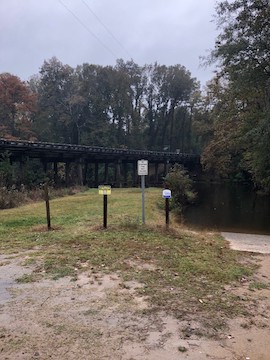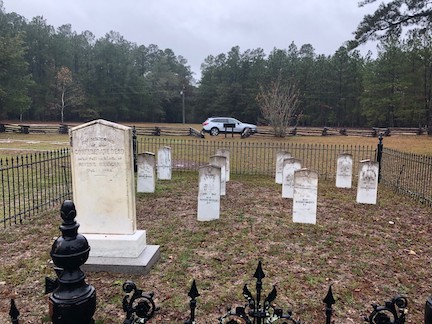Chasing Uncle Billy: Breaching the Line of the Salkahatchie River (part two)

(part two of two)
On February 1, 1865, Maj. Gen. William T. Sherman’s might army crossed into South Carolina and began moving north. He kept his two wings separated for a variety of reasons: to confuse the Confederates as to his intentions, and to ensure that different wings were using different road networks. By February 2, they had reached the Salkahatchie River line.
The Union XVII Corps, of Sherman’s Left Wing, advanced on River’s and Broxton’s Bridges, while the XV Corps was ordered to advance on Buford’s Bridge. On February 2, the soldiers of Maj. Gen. Frank Blair’s XVII Corps reached their objections at River’s and Broxton’s Bridges. That day, Union soldiers of Maj. Gen. Joseph Mower’s division of the XVII Corps tried to force their way across the Salkahatchie at Broxton’s Bridge, but were unable to do so. They then marched six miles upstream, headed for River’s Bridge. Responding, Blair ordered his engineers to build bridges and roads across the Salkahatchie swamp to try to bypass Maj. Gen. Lafayette McLaws’ defenses at River’s Bridge.

The next day, February 3, two brigades of Mower’s division of the XVII Corps waded through the swamps and launched an all-out assault on the Confederate right. At the same time, another division of the XVII Corps waded the Salkahatchie downstream, flanking McLaws out of his strong position on the north bank of the river. Each side suffered about 100 casualties in this nasty engagement, but Beauregard’s little army could ill afford any losses. The Union victory gave Sherman’s Left Wing possession of the countryside to the north of the Salkahatchie, and ultimate resulted in the cutting of the South Carolina Railroad, an important supply line.
In the meantime, the XV Corps advanced on Buford’s Bridge, but its defenders were also forced to withdraw when McLaws was flanked out of his position at River’s Bridge. His flank turned, McLaws had no choice but to withdraw and fall back in the direction of Branchville. By doing so, McLaws abandoned southeastern South Carolina to the tender mercies of Sherman’s army. His soldiers blamed South Carolina for beginning the Civil War, and they were determined to punish its citizens for doing so. Thus began was later described as a carnival of destruction.

Beauregard’s carefully planned defense of the Salkahatchie River line hence lasted for a total of two days. It was doomed by having too few men to hold the position effectively, meaning that his defensive line had no depth. Similarly, Beauregard did not count on the efficiency and brilliance of the Union engineers and pioneers, who made the impassable swamps passable after all. Forced to fall back to the central part of the state, Beauregard now intended to stand and fight on the line of the Edisto River, south of the state capital at Columbia. However, he never got the chance. But that’s another story for another day.
Wade and I will very soon be ready to begin writing our detailed military study of Sherman’s passage through South Carolina. I expect to have more stories from that study as we proceed.

I look forward to any publication y’all put out about the campaign through the Carolinas. I just found out I had an ancestor with the 32nd Wisconsin, which was part of Mower’s division in the XVII Corps. If you can recommend any books on the subject, I’d like to check them out as well. Thanks for sharing your journey!
Glorifying one who history, and many people, to believe Sherman a war criminal. After the war, he then went on to ply his murderous destruction of the native Americans. Glorifying the victors while overlooking the Constitution and Bill of Rights violations in so many ways. The Founding fathers were surely spinning in their graves.
Alrighty then. The Lost Cause always has to make an appearance. Unfortunate but not unexpected.
You should stop posing as an advocate for Native Americans with your thinly-cloaked agenda and stop using them as props for something else Maybe you can tell us how the the Cherokees ended up where they were when the war began, where they had lived before that, and why they “moved”. As for the Founding Fathers you appear to be fundamentally uninformed as to George Washington’s views on the subject – which were not unlike the views one Robert E. Lee expressed to one of his sons in January 1861. Reading and facts are your friends..
Robert:
War criminal? What on earth are you talking about? Sherman’s march through Georgia and the Carolinas shortened the CW by many months, thus saving thousands and thousands of lives – both Confederate and Union. Also, the Georgia/Carolinas march was accomplished with a bare minimum of casualties – both Confederate and Union.
Blaming Sherman for the travails of Native Americans in the West is a gross oversimplification. By the way, the Navajo were allowed to return to their homeland in Arizona and New Mexico from their devastating exile in Bosque Redondo mainly because of Sherman. Today, the Navajo Ariz./N. Mex. reservation is the largest in the U.S.
You assume that Robert is interested in facts.
The victor always writes history, ignoring and vilifying the Southland for exercising their constitutional rights. The people democratically voted as free people to form their own government, as was their right, or for any state. Waging war against the civilian population, de-populating large areas, burning them out of their homes, shipping factory workers, mostly women, up north, most, never to be heard from again. The list goes on.
The reason leaders of the South were never prosecuted was because the cases would make their way to the Supreme Court, where, the justices could have found that the federal government waged an unconstitutional war on the States. You people do not give a balaced view of both sides. They all were and are all Americans.
Like I said, the Lost Cause has to rear its ugly, obnoxious head. Mr. Rainey proves me right once more.